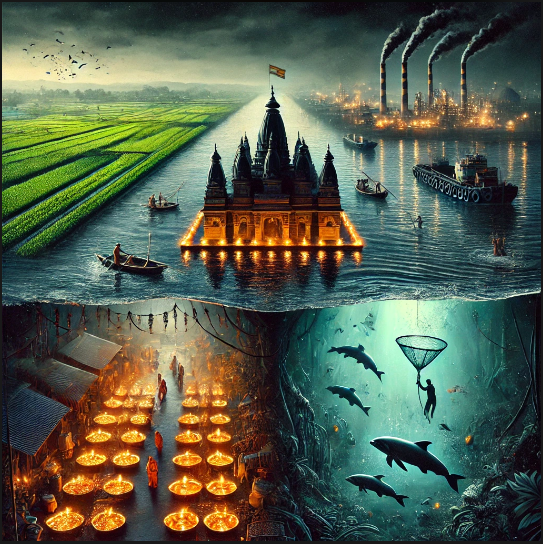Introduction
The Ganga, also known as the Ganges, is not just a river but a symbol of purity, spirituality, and sustenance. Flowing for over 2,500 km, it originates from the Gangotri Glacier in the Himalayas and passes through several Indian states before emptying into the Bay of Bengal. The river is deeply woven into the history, culture, and daily lives of millions of people in India and Bangladesh. Despite being revered and vital, the Ganga faces numerous threats such as pollution, over-extraction, and climate change, making its conservation a priority.
Religious and Cultural Significance
1. Sacred River in Hinduism
The Ganga is considered a divine river in Hinduism and is personified as the goddess Ganga. According to Hindu mythology, the river descended from the heavens to Earth through the efforts of King Bhagirath, making it a purifier of sins. Pilgrims take ritual baths in its waters, believing it leads to spiritual purification and salvation (moksha).
2. Important Religious Cities
Several religious cities are situated along the banks of the Ganga:
- Varanasi – Known as the spiritual capital of India, it is believed that dying here and having one’s ashes immersed in the Ganga ensures salvation.
- Haridwar – Hosts the grand Kumbh Mela, one of the largest religious gatherings in the world.
- Prayagraj (Allahabad) – The confluence of the Ganga, Yamuna, and the mythical Saraswati at Triveni Sangam is a sacred pilgrimage site.
3. Festivals and Rituals
Many Hindu festivals are associated with the Ganga, such as:
- Ganga Dussehra – Celebrates the descent of the river from heaven.
- Chhath Puja – A festival where devotees worship the Sun God on the banks of the Ganga.
- Kumbh Mela – A mass pilgrimage where millions take a holy dip in the river.
4. Influence on Art, Literature, and Music
The Ganga has inspired Indian poets, writers, and musicians for centuries. Classical Indian music and dance have often depicted the river’s divinity and grandeur. Several Indian paintings and sculptures represent the river as a symbol of purity and wisdom.
Economic and Agricultural Importance
1. Fertile Plains and Agriculture
The Ganga basin is one of the most fertile agricultural regions in the world, supporting food production for millions. Key benefits include:
- Irrigation for crops like wheat, rice, sugarcane, and pulses.
- Alluvial soil deposits due to periodic floods enhance soil fertility.
2. Livelihood and Employment
Millions of people depend on the Ganga for their livelihood, including:
- Farmers – Depend on the river for irrigation.
- Fishermen – The river supports diverse fish species like Rohu and Catla.
- Boatmen and Tourism Workers – Tourists visiting Varanasi, Haridwar, and Rishikesh generate income for boat operators and local traders.
3. Industrial and Commercial Use
Many industries, including textile, leather, and paper industries, are located near the river, utilizing its water for production and transport. However, these industries have also contributed to pollution, necessitating sustainable practices.
Ecological and Environmental Significance
1. Biodiversity Hotspot
The Ganga and its tributaries support diverse wildlife, including:
- Ganges River Dolphin – An endangered species found only in the Ganga and Brahmaputra rivers.
- Gharial (Crocodile species) – An ancient reptile found in the river’s ecosystem.
- Migratory Birds – Birds like Siberian cranes and flamingos visit the wetlands during winters.
2. Wetlands and Mangroves
The Ganga delta, home to the Sundarbans, is the world’s largest mangrove forest and a UNESCO World Heritage Site. It acts as a natural shield against coastal erosion and cyclones.
3. Climate Regulation and Groundwater Replenishment
The river plays a key role in regulating the region’s climate by:
- Replenishing groundwater reserves.
- Supporting monsoon cycles by interacting with weather patterns.
Threats to the Ganga
1. Pollution and Contamination
- Industrial Waste – Factories discharge chemicals and heavy metals into the river.
- Sewage Waste – Cities along the Ganga release untreated sewage, making it unsafe for drinking.
- Plastic and Solid Waste – Garbage disposal and religious offerings wrapped in plastic contribute to pollution.
2. Climate Change and Glacial Melting
The Gangotri Glacier, the source of the river, is shrinking due to rising global temperatures, threatening water availability in the future.
3. Over-Extraction of Water
Excessive water withdrawal for irrigation and industrial use has led to declining water levels, disrupting aquatic ecosystems.
4. Deforestation and Land Erosion
Illegal sand mining and deforestation in the Ganga basin increase soil erosion, affecting agricultural productivity and water quality.
Government and Conservation Efforts
1. Namami Gange Programme
Launched in 2014, this initiative focuses on:
- Sewage treatment plants to prevent waste discharge.
- River surface cleaning to remove floating debris.
- Biodiversity conservation to protect species like the Ganges dolphin.
2. Ganga Action Plan (GAP)
Initially launched in 1985, the GAP aimed to:
- Control industrial pollution.
- Promote afforestation along the riverbanks.
3. National Green Tribunal (NGT) Regulations
The NGT has imposed strict penalties on industries dumping waste into the river.
4. Community Involvement and Awareness Campaigns
NGOs and social activists conduct:
- Clean Ganga drives – Encouraging local participation.
- Education campaigns – Teaching schoolchildren the importance of keeping the river clean.
Role of Citizens in Ganga Conservation
Every citizen can contribute to Ganga conservation by:
- Reducing plastic waste and using biodegradable materials.
- Supporting eco-friendly religious practices, like immersing idols made of natural clay instead of toxic chemicals.
- Participating in tree plantation drives to prevent soil erosion.
- Using water responsibly to prevent over-extraction.
Conclusion
The Ganga is not just a river but the lifeline of India, influencing its culture, economy, environment, and spirituality. However, rising pollution, climate change, and human exploitation threaten its existence. Protecting and preserving the Ganga requires collective efforts from the government, industries, and citizens. With proper conservation strategies, sustainable practices, and awareness, we can ensure that the sacred Ganga remains pure and vibrant for future generations.




